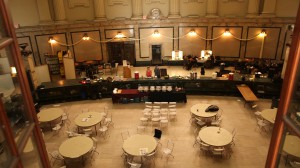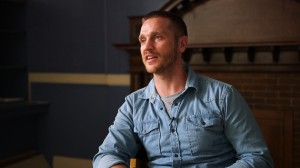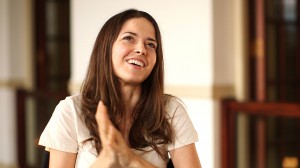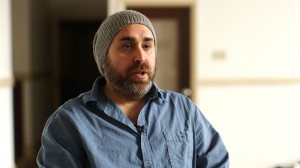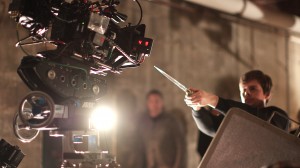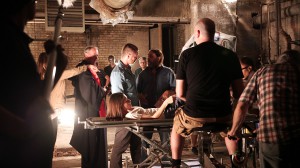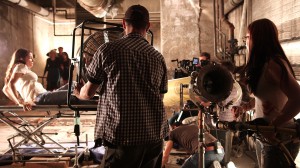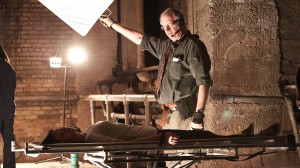Hey all, Jordan here! Earlier this year I flew to Winnipeg to shoot EPK (electronic press kit AKA behind the scenes) footage and interviews for a 20th Century Fox horror movie. Despite all the e-mails and phone calls I had been through to organize and prepare for this shoot, I knew it was going to be a nightmare of day if I wasn’t ready to be flexible and think on my feet. The details of how the shoot was going to unfold were hazy at best, as the production was so massive that no one person had a handle on everything going on. A big film set is usually a well-oiled machine, but the fact remains that there are hundreds of moving parts and people and you’ve got to be ready for anything.
The setup
I arrived on set (which was the Millenium Centre, an old-fashioned former bank building located in downtown Winnipeg) with the half a dozen journalists and film critics I’d be spending the day with and met with one of the film’s producers. We were led to an upstairs gallery which was to be our green room and interview space for the day. Below us was the expansive and ornate main floor of the building, which was filled with craft services and make-up; below that was the creepy underground section of the structure where all the actual filming for the day was happening; and finally in the surrounding neighbourhood there were various wardrobe and talent trucks.
In terms of gear I had a Canon C100, Sigma 18-35mm f/1.8, Canon 24-105mm f/4, Canon 50mm f/1.2, Canon 70-200mm f/4, tripod, monopod, and a wireless lav mic. I decided to shoot with the “Standard” picture profile because I knew that my footage would be sent to various media outlets that probably wouldn’t have the resources for colour grading. Also, as a one-man-band shooting in an unpredictable situation, having the added contrast and sharpness of a non-flat image really helps a lot with maintaining focus on the C100’s small LCD viewfinder.
Interviews
Normally when filming interviews I have the interviewer sitting immediately to the left or right of the camera. This ensures that the interviewee has a good eye line and isn’t looking too far out of the frame. The issue with this shoot however is that I was working with six other reporters who would be asking questions. In an ideal world I would have done a separate interview with each of the cast and crew members either before or after the print journalists did their interviews. But a fast-paced film set is not an ideal world and we had very limited time with each subject.
It was an unusual situation but in the end I adapted by collaborating with everyone and piggy-backing onto their media panel line of questions. I soon learned which journalists were the most vocal and inquisitive and seated them directly to camera-left or camera-right. Meanwhile, I placed the quieter and more passive interviewers farthest from me – this enabled me to have the subjects maintain a closer eye line for the majority of the shoot.
With a couple exceptions I had nine interviews to compose in the same space. I did my best to change up the background and looking room of each interviewee so that there would be some variety to the shots. Fortunately, I had lots of natural light and angles to work with, so I think I managed to capture some decent frames despite being confined to one room. Also, since I was shooting with only one camera, I used the Sigma 18-35mm f/1.8 so that I could change the focal length in between questions and get a mix of mediums and wides on my interview subject framing.
Behind the scenes
As I mentioned earlier, the actual set was located in the catacomb-like bowels of building – which meant that it was very dark, dank, dirty, cramped, and crowded. Aside from capturing some cool EPK footage, I soon learned three other things I had to keep in mind:
1. Stay out of the way
2. Don’t capture anything that could be considered a spoiler to the story
3. Like Batman, be aware of your surroundings and move like a ninja
Given the location conditions, there was absolutely no way I would be able to maneuver with a tripod, so I opted instead to mount my C100 on a monopod. Handheld was in the mix as well, but because I had to keep my distance and stick to the shadows, I used longer lenses where some stabilization is required.
Speaking of lenses, I changed them sparingly and strategically. If I swapped glass I was stuck with it for the next little while. A monopod-mounted camera in a dusty cave with no space or furniture on which to set anything down makes for a difficult lens change procedure; which is why I found the Canon 24-105mm f/4 so useful. The focal length is versatile, the weather-sealing was handy in the harsh environment, and the lens is sharp and sturdy.
That’s a wrap!
I didn’t know much about what to expect going into this shoot, but because I was able to adapt and change on the fly, this horror film actually turned out pretty well! It wasn’t challenging on a technical level, but it’s important to remember that, as filmmakers, we need to sometimes step out from behind the camera and get a sense of the logistical big picture. Definitely have a plan; be prepared, but most of all be prepared for when your plan doesn’t apply anymore.
– Jordan


